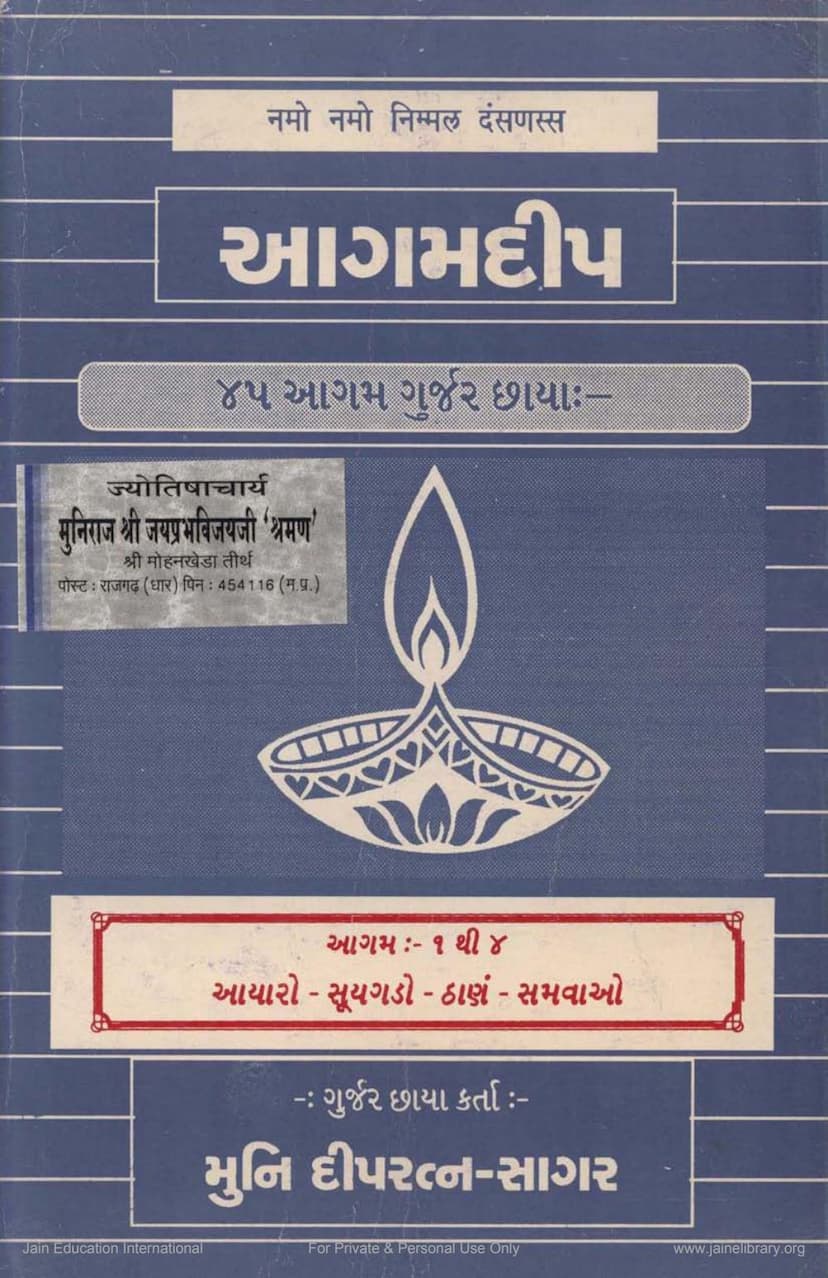Agam Deep 16 Surpannatti Gujarati Anuvaad
Added to library: September 1, 2025

Summary
The provided text is a Gujarati translation and commentary ("Gujar Chhaya" by Muni Deepratna Sagar) of the Jain Agam Sutra "Surya Prajnapti" (or "Surpannaṭṭi"), which is the fifth Upanga Sutra. The work is part of a larger series titled "Agam Deep." The translation aims to make this complex Jain scripture accessible to Gujarati readers.
Here's a breakdown of the content based on the provided pages:
Introduction and Publisher Information:
- The book is titled "Agam Deep 16 Surpannatti Gujarati Anuvaad" and is authored by Dipratnasagar and Deepratnasagar.
- Published by Agam Shrut Prakashan.
- It includes invocations to the Jin, specifically to Lord Parshvanath and Lord Neminath, and to revered gurus.
- The publisher's details, including contact information and a price of Rs. 2000 for the "Agam Deep - Gurjar Chhaya" set, are provided.
- Various individuals and organizations are acknowledged as financial supporters and patrons for this publication.
Content of Surya Prajnapti (as translated): The core of the text is the explanation of astronomical and cosmological concepts as understood in Jainism, presented through dialogues between Lord Mahavir and his disciple Indrabhuti Gautam. The translation/commentary breaks down the complex discussions into "Pahuḍ" (sections) and "Pahuḍ-Pahuḍ" (sub-sections). Key themes covered include:
-
The Sun's Journey and Calculations:
- Detailed discussions on the number of "mandals" (spheres or orbits) the sun traverses in a year.
- Explanation of the sun's "tirthik gati" (movement).
- Calculations regarding the number of "kshetras" (regions) illuminated by the sun and moon.
- The limits and arrangement of light (prakasha).
- Discussions on "paurushee chhaya" (shadow measurement), "samvatsara" (year) and its beginning, the growth of the moon, and the characteristics of light.
- The concept of "muhurta" (a unit of time) and its increase and decrease.
- The sun's movement through different spheres and its speed variations.
- The day and night cycles and their measurement in "muhurta."
- The number of suns and their influence ("anubhav").
-
Celestial Bodies and Time Measurement:
- Discussions on constellations ("nakshatras"), their arrangement, and their influence.
- Details about "muhurta" and their calculations.
- The concept of day and night and their duration.
- Names and cycles of "tithis" (lunar days).
- The origin and position of constellations.
- The "adhipati devatas" (controlling deities) of celestial bodies.
- The concept of "yog" (conjunctions) of celestial bodies.
- The names and durations of months and years.
- The structure and arrangement of "mandals" (spheres).
-
Cosmological Differences of Opinion:
- The text presents various philosophical viewpoints from different schools of thought (per-tirthikas) regarding the sun's movement, the size of islands and oceans, the number of suns, and the formation of spheres. Lord Mahavir then refutes these incorrect views with the Jain perspective.
-
Specific Astronomical Details:
- Detailed explanations of the sun's path through various spheres ("mandals"), covering daily, monthly, and yearly cycles.
- Calculations involving "yojana" (a unit of distance) and "muhurta" to determine the sun's progress and the resulting day and night lengths.
- The text delves into the intricate details of how the sun's journey affects the duration of days and nights in different hemispheres and seasons, explaining the gradual increase and decrease in daylight and darkness.
- It discusses the concept of "ardha-mandala" (half-spheres) and how the sun's movement within them causes these changes.
- The text also addresses the "tirthik gati" of the sun and the "yog" (conjunctions) of stars and planets.
- It specifies the number of stars in each constellation and the duration of their interaction with the moon and sun.
- The text explains the names of the months and the constellations associated with their full moon days.
- It details the sequence of constellations during different times of the year and their relationship with the sun and moon.
- Discussions on the qualities of various constellations, their shapes, and the number of stars within them.
- The text also covers the presiding deities of each constellation.
- It provides extensive detail on "muhurta" and their names, as well as the names of days within the lunar fortnight (tithis).
- The text attempts to clarify astronomical phenomena, such as eclipses, and the role of "Rahu" in them, presenting both external and Jain viewpoints.
- It discusses the dimensions of the universe, including the sizes of "dvipas" (islands) and "samudras" (oceans), and the distances between celestial bodies.
- The text details the arrangement of various spheres ("mandals") and the celestial bodies within them.
- It explains the concept of "paurushee chhaya" (a measurement related to shadows) and its significance.
Commentary and Translation Style:
- The "Gujar Chhaya" provides explanations and clarifications for the original Prakrit or Sanskrit terms and concepts.
- It uses a conversational style, often presenting the questions asked by Indrabhuti Gautam and the answers given by Lord Mahavir.
- The commentator, Muni Deepratna Sagar, is credited with making the complex subject matter understandable.
Overall Significance: This work is valuable for understanding the Jain perspective on cosmology and astronomy, which is deeply intertwined with their philosophy and practices. The "Agam Deep" series, and this volume in particular, aims to preserve and disseminate these ancient teachings. The focus on "Surya Prajnapti" highlights the importance of celestial knowledge within Jainism, likely for calendrical, astrological, and philosophical purposes.